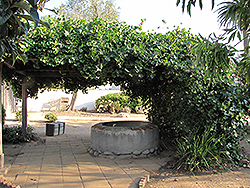20 feet
24 inches

6b
Southern Fox Grape
Muscadine Grape is primarily grown for its highly ornamental fruit. It produces abundant clusters of deep purple grapes with black overtones in late summer. It has rich green deciduous foliage which emerges coppery-bronze in spring. The serrated heart-shaped leaves turn yellow in fall.
This plant is primarily grown as an ornamental, but it's also valued for its edible qualities. The small round sweet fruit is most often used in the following ways:
- Fresh Eating
- Preserves
- Juice-Making
- Wine-Making
Muscadine Grape is a dense multi-stemmed deciduous woody vine with a twining and trailing habit of growth. Its relatively coarse texture can be used to stand it apart from other landscape plants with finer foliage.
This is a high maintenance woody vine that will require regular care and upkeep, and requires a special pruning regimen to reliably produce fruit; consult a specific reference guide or contact the store for proper pruning techniques. It is a good choice for attracting birds to your yard. Gardeners should be aware of the following characteristic(s) that may warrant special consideration;
Muscadine Grape is recommended for the following landscape applications;
- Hedges/Screening
- General Garden Use
- Orchard/Edible Landscaping
Muscadine Grape will grow to be about 20 feet tall at maturity, with a spread of 24 inches. As a climbing vine, it should be planted next to a fence, trellis or other rigid structure where it can be trained to grow upwards on it. It grows at a fast rate, and under ideal conditions can be expected to live for approximately 20 years. This is a self-pollinating variety, so it doesn't require a second plant nearby to set fruit.
This woody vine should only be grown in full sunlight. It does best in average to evenly moist conditions, but will not tolerate standing water. It is very fussy about its soil conditions and must have sandy, acidic soils to ensure success, and is subject to chlorosis (yellowing) of the foliage in alkaline soils. It is somewhat tolerant of urban pollution. Consider applying a thick mulch around the root zone in winter to protect it in exposed locations or colder microclimates. This species is native to parts of North America.













